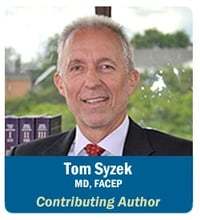 A few years ago, I invited one of our malpractice defense attorneys to shadow me for a shift in the emergency department. At the end of the day, after he had seen every patient with me and watched me document every chart, I asked him to share any observations. He said, “It shocks me that so little of what you see and do is actually documented.” And I thought my documentation was outstanding! He went on to explain that I captured only a fraction of the information I gathered by observing, speaking with, and re-examining the patients throughout their stay. He felt that the medical record would not adequately reflect how sick or well the patients really looked to us that day, particularly if any of those cases resulted in a malpractice suit; he lamented that any subsequent reader of the medical record, including a jury, would not get the whole picture.
A few years ago, I invited one of our malpractice defense attorneys to shadow me for a shift in the emergency department. At the end of the day, after he had seen every patient with me and watched me document every chart, I asked him to share any observations. He said, “It shocks me that so little of what you see and do is actually documented.” And I thought my documentation was outstanding! He went on to explain that I captured only a fraction of the information I gathered by observing, speaking with, and re-examining the patients throughout their stay. He felt that the medical record would not adequately reflect how sick or well the patients really looked to us that day, particularly if any of those cases resulted in a malpractice suit; he lamented that any subsequent reader of the medical record, including a jury, would not get the whole picture.
The Picture Is Yours to Paint
Compare the following two descriptions of the same 2-year-old who presents with a history of fever and vomiting. Which statement below, A or B, is more convincing that this child is well and unlikely to have a serious bacterial illness?
A. The child is awake and non-toxic in appearance.
B. The child is awake, alert, sitting on the stretcher. He is smiling, active, playing with toys on the bed, watching the TV, interacting with his mother, eating chips and drinking from a cup, and has good tone and color. When placed on the floor he walks without difficulty, laughs, and runs to his mother.
While statement A is an adequate but brief description of a well child, statement B paints a more vivid picture. If this child were to return the next day with meningitis or sepsis, which statement would you prefer to have in your chart to support your contention that the child appeared well?
First Impressions Are Crucial
Of all the elements in the physical exam, perhaps the most important to document thoroughly are the two features we first encounter: general appearance and activity. Particularly when faced with a high-risk chief complaint such as abdominal pain, chest pain, headache, pediatric fever, altered mental status or trauma, it is essential for practitioners to make it absolutely clear how the patient looked and acted.
 If you ever took a creative writing or art course in college, this is your chance to use those talents in your medical practice. You don’t need to use a thousand words to “paint” a picture, but a few descriptive sentences will convey your first impression to anyone who later reads the chart. The lay public understands “looks and deeds” better than they understand rebound tenderness or a Babinski reflex.
If you ever took a creative writing or art course in college, this is your chance to use those talents in your medical practice. You don’t need to use a thousand words to “paint” a picture, but a few descriptive sentences will convey your first impression to anyone who later reads the chart. The lay public understands “looks and deeds” better than they understand rebound tenderness or a Babinski reflex.
Consider two more chart entries for a 62-year-old man with a headache. Which statement, A or B, paints a more convincing picture of wellness?
A. He is awake on the stretcher.
B. He is awake, alert, sitting up, reading a pamphlet, and talking about the weather with his wife. He is pleasant, comfortable in appearance, and cooperative with the exam.
When he is discharged home and returns the next day with a subarachnoid hemorrhage, which statement, A or B, would you prefer to have in your chart documentation?
Benefits of Quality EMR Documentation
Most of the diagnostic errors in primary care, urgent care and emergency medicine involve patients who are sent home rather than admitted to the hospital. If the patient you send home experiences an unanticipated bad outcome later, consider the following benefits of good charting, which includes a detailed description of general appearance and activity consistent with wellness:
- It’s more reliable than personal recollection.
- Demonstrates good communication.
- Demonstrates quality medical care.
- Plaintiff attorney may not take the case.
The famous rock performer Rod Stewart insists in one of his better-known songs that “Every picture tells a story, don’t it!” When it comes to high-quality, defensible EMR documentation of a patient’s general appearance and activity, the opposite is true: “Every story paints a picture.” Make sure that your documentation “story” paints a picture so compelling and logical that any reasonable practitioner and every juror can only come to one conclusion – the same as yours.


